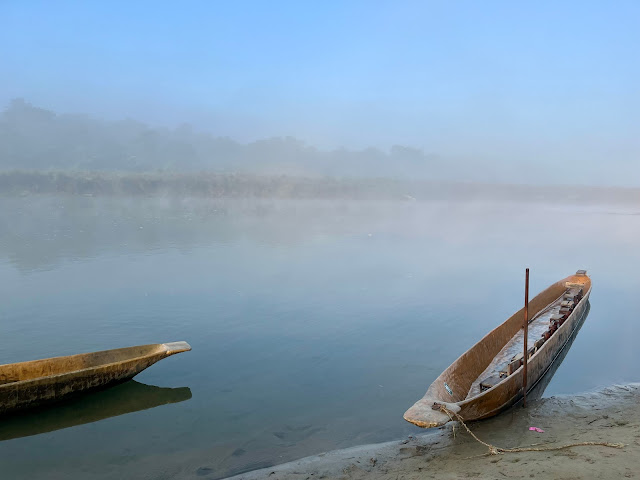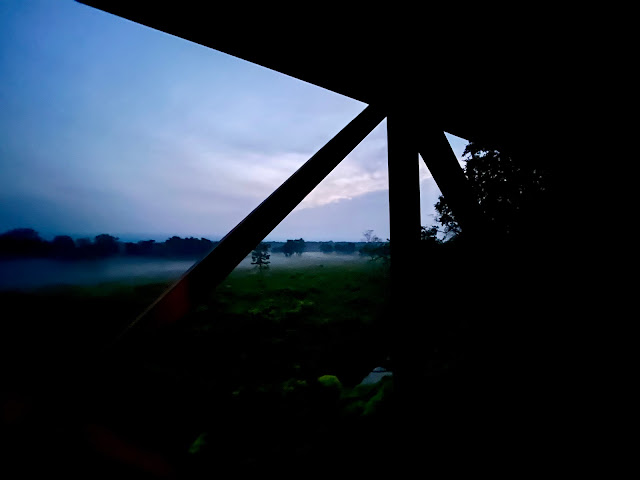We've got to talk about Chitwan.
Hoo boy, where to start. Chitwan, a town in the southern part of Nepal, is a truly wild place. It is literally wild in that it is home to a national park boasting tigers, rhinos, sloth bears, elephants and four species of deer. But it also has this kind of wild west, anything goes vibe that ultimately raises more questions than answers.
I, along with every other visitor, was there with the hopes of seeing a Bengal Tiger. In order to do that, I contacted my hotel ahead of time to set up a safari. The very helpful owner responded immediately with a list of options. Chief among them was an 8 hour walking tour within the park. This seemed like a very vulnerable position to put yourself in when encountering a tiger but surely they know what they are doing. Still, that much walking in hot, humid weather sounded less than ideal, even absent a tiger attack. I opted to think it over.
After yet another bone-jarring bus ride, this time from Pokhara to Chitwan, I checked into the hotel and settled on a final itinerary. I would do a canoe safari, 2 jeep safaris, a 4 hour walk through the park and a night in a jungle tower. Surely I would see a tiger with all of those opportunities. However,the schedule I was given felt a bit strange. I've done at least a dozen safaris in seven different countries. The one constant has always been the timing, they are always either at sunrise or sunset. It is well-established that most wildlife is smart enough to just chill during the hottest parts of the day. The best chances of encountering anything is thus early morning or late afternoon.
The first activity, a canoe ride followed by the walking safari, wouldn't begin until 9am, well after sunrise. Ok, that's odd but it gave me an opportunity that first evening to watch the sunset by the river and check out the town's surprisingly robust nightlife.
The next morning, our ride in the dugout canoe was pretty chill with lots of bird sightings and a couple of crocs and gators basking in the sun. This is presented as a separate activity but the river is the dividing line between the town and the national park so anytime you are entering the park, you are most likely taking a canoe.
The main event was the walking tour. It is mandated that each group have two guides, one leading the way and the other bringing up the rear. They are equipped only with sticks and hopefully a strong knowledge of animal behavior. Our group consisted of the two guides, a couple, a girl from New Zealand and myself. By way of introduction, our guide explained what we should do if we encounter wild animals. If we spotted a rhino, we were to climb the nearest tree. This is a good time to point out that in my life, I have never climbed a tree. He was about to continue with his instructions when he remembered that the last time he went through his whole spiel, a girl in the group started crying, so better to stop at the rhino. Weird, when there are tigers in our midst, but whatever...
Eventually, the rhino got bored and wandered back into the grasses. But the guide's reaction left us with a lot of questions. How common are animal attacks within the park? As it turns out, the answer is very common. Google "Chitwan, animal attacks" and you get a disturbing number of hits. There's this, this and don't miss this account of tourists watching their guide get mauled by a sloth bear. We were told the story of a tiger whose reputation for killing humans was so well-known, he had been given a name. I forget what it was but let's call him Fred. Fred had such a high body count that authorities had no choice but to capture him. But what to do next? Tigers are endangered and to quote Chris Rock, the tiger hadn't gone crazy, the tiger had simply gone tiger. You can't kill the tiger but perhaps you can relocate him to a less populated area or maybe find him a sanctuary. But they did none of those things, much like the church with a pedo priest, they simply just moved him over to the next town. Fred did not appreciate this and has since made his way back to Chitwan. Our guide's advice: "He has a very big head. If you see a tiger with a very big head, that's probably Fred. You should be careful." Ya think?
 |
| Lusty living? |
After lunch, we returned to the park for our jeep safari. It was 2pm. In the best of circumstances, this is not a great time to do a safari and these were far from the best of circumstances. Doing a safari while the grasses are as high as they are is the equivalent of going whale watching in the off-season. Sure, you might get lucky and see an errant dolphin but you best go in with some lowered expectations. For over four hours, we drove around with a guide who knew better than any of us how futile this was yet he still tried his best. We did see some rhinos in the distance, a couple of deer and lots of birds but mainly we just cruised around a pretty park.
I wasn't giving up. The large number of tigers in the park is a result of successful conservation efforts. Because of the burgeoning numbers, the older tigers are having a hard time competing with the younger ones for prey. Their solution is to find slower prey, naming humans and their pets, thus they have moved into the buffer zone, the area standing between the park itself and the village.
I signed up for a safari of the buffer zone itself. Counterintuitively, you have better odds of spotting wildlife here than in the actual park. This is because the harvesting of the grasses is allowed and the elevated layout of the roads gives you a better vantage point into the grasses that remain.
I mentioned in my earlier post that there are two distinct types of tourism in Nepal- one for westerners and one for Nepali and Indian tourists. The buffer zone is very much the realm of the local tourists. In my jeep, there was a Nepali school group and a handful of Indian visitors. The guide gave his instructions in Hindi, something that caused a lot of concerned looks in our group. I patiently awaited the translation. When it didn't come, I asked "Hey, is there anything I need to know? I saw you said something earlier." The guide explained that he was asking for the adults to sit on the outside seats with the children in the middle because of the tigers. Um. "Wait, follow up question. Do the tigers actually jump onto the jeeps?" His answer, which will forever be seared into my memory was "No no no sometimes yes". Just like that. He said it calmly and with no punctuation whatsoever. No no no sometimes yes. "What is happening in this park?!!" It was meant as a rhetorical question but of course, I got an answer. The prior evening, a tiger had killed a man in the very same area where we would be driving through. But of course he had.
When I broke this news, later in the day, to the owner of the hotel, he admitted that this happened all the time. Seeing the shock on my face and realizing this isn't great for business, he quickly clarified that the tigers only eat Nepali people. Lest you believe the tigers are nationalistic snobs that require a certain amount of spice in their diet, there are plenty of instances of tigers (and rhinos and elephants and...) killing tourists, even within the town itself. However, statistically it is more likely to be locals, since they are the ones entering the park and/ or buffer zone in the dark, usually by themselves to gather firewood.
As predicted, the buffer zone safari was more successful than the park one. We spotted all four species of deer (spotted, hog, sambal and barking deer), a couple of rhinos, some monkeys and yet more birds. Also zero tigers.
My last chance at spotting the elusive feline was my tower stay. I would be staying in the middle of the jungle in a tower hotel. From this vantage point, I could see off into the distance and fall asleep to the sound of the jungle noises.
It's a cool idea, which should be more popular than it is. On this evening, I was the only guest in the entire tower. The guide and I watched as the sunset, observing three rhinos just ambling along. In the distance, there was lone deer chilling. The guide thought he heard a tiger (or he said that just to humor me, anything is possible). As soon as it got dark, there was really nothing to see or do. The tower had electricity and running water but no wifi so I sat and knit in the middle of the jungle.
It was still dark the next morning when the guide suggested we return back to the pickup spot, something that involved a 30 minute walk through the jungle. Seriously, dude? Knowing what I now knew about Chitwan, there was zero chance I was walking around in the dark. We waited until the sun came up before beginning our journey back. Along the path, he found a fresh tiger paw print in the dirt. He had been walking in the direction of the tower. Damn it, Fred. I had really hoped to see a tiger in the wild.
Even though I hadn't seen a tiger, Chitwan had proven to be akin to an adrenaline sport. Will you make it or will you get stomped by a rhino on the way to the liquor store? Anything can happen and perhaps that is part of its charm. Is it crazy that I felt that way? To quote on the great philosophers of our times, no no no sometimes yes.






































Comments
Post a Comment